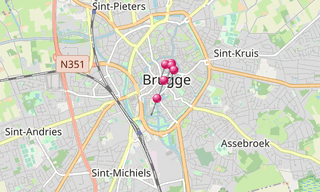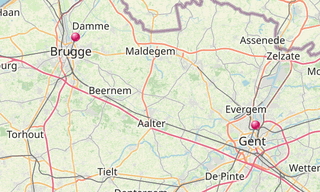Bruges is the capital of the province of West Flanders. It has most of its medieval architecture intact. The historic centre of Bruges has been a UNESCO World Heritage Site since 2000. Many of its medieval buildings are notable, including the Church of Our Lady, whose brick spire reaches 122.3 m, making it one of the world’s highest brick buildings.
The sculpture Madonna and Child, which can be seen in the transept, is believed to be Michelangelo’s only sculpture to have left Italy within his lifetime. Bruges’ most famous landmark is its 13th century Belfry, housing a municipal carillon comprising 48 bells.
Main sights
- The Church of Our Lady of Bruges (Onze Lieve Vrouwekerk) is a Catholic religious building in Gothic style built in the 13th and 14th centuries, the church has a tower 115.6 m high (not counting the cross), whose spire alone measures 54 m, making it one of the tallest brick buildings in the world.
- The Belfry of Bruges is a medieval bell tower in the centre of Bruges. One of the city’s most prominent symbols, the belfry formerly housed a treasury and the municipal archives, and served as an observation post for spotting fires and other dangers.
- The Princely Beguinage Ten Wijngaerde is the only preserved beguinage in the Belgian city of Bruges. There are no more Beguines living there, but since 1927 it has functioned as a convent for Benedictines, founded by canon Hoornaert. Already before 1240 a community of pious women settled at the domain “de Wingarde” (vineyard), in the South of the city. The beguinage was founded around 1244 by Margaret of Constantinople, after she requested permission to Walter van Marvis, bishop of Tournai, to move over the tomb chapel on the Burg of Bruges to the Wijngaard.
- The Basilica of the Holy Blood (Heilig-Bloedbasiliek) houses a relic of the Holy Blood allegedly collected by Joseph of Arimathea and brought from the Holy Land by Thierry of Alsace, Count of Flanders. Built between 1134 and 1157 as the chapel of the Count of Flanders, it was promoted to a minor basiica in 1923.
- The Old Saint John’s Hospital (Oud Sint-Janshospitaal) was a medieval hospital in Bruges. It was founded in the mid-12th century. Located next to the Church of Our Lady, the premises contain some of Europe’s oldest surviving hospital buildings. The hospital grew during the Middle Ages and was a place where sick pilgrims and travellers were cared for.
- The Bruges City Hall (Stadhuis) is one of the oldest city halls in the entire region. Count Louis laid the foundation stone. Responsibility for its construction was given Jan Roegiers, and the project was completed, eventually, in 1421.
- The Province Court (Provinciaal Hof) is a Neogothical building on the market place in Bruges. It is the former meeting place for the provincial government of West Flanders.

-Rozenhoedkaai.hero.landscape.jpg?w=1600)

-Rozenhoedkaai.jpg?w=256)
-Basiliek-van-het-Heilig-Bloed.jpg?w=256)
-Begijnhof-Ten-Wijngaerde.jpg?w=256)
.jpg?w=256)
-Peerdenbrug.jpg?w=256)
-Begijnhof-Ten-Wijngaerde.jpg?w=256)
-Begijnhof-Ten-Wijngaerde.jpg?w=256)
-Begijnhof-Ten-Wijngaerde.jpg?w=256)
.jpg?w=256)
-Begijnhof-Ten-Wijngaerde.jpg?w=256)
.jpg?w=256)
-Stadhuis-van-Brugge.jpg?w=256)
-Begijnhof-Ten-Wijngaerde.jpg?w=256)
.jpg?w=256)
-Provinciaal-Hof.jpg?w=256)
-Sint-Janshospitaal.jpg?w=256)
.jpg?w=256)
.jpg?w=256)
.jpg?w=256)
-Provinciaal-Hof.jpg?w=256)
.jpg?w=256)
-Sashuis-aan-het-Minnewater.jpg?w=256)
-Provinciaal-Hof.jpg?w=256)
-Stadhuis-van-Brugge.jpg?w=256)
-Basiliek-van-het-Heilig-Bloed.jpg?w=256)
.jpg?w=256)
.jpg?w=256)
.jpg?w=256)
-Belfort-van-Brugge.jpg?w=256)
-Rozenhoedkaai.jpg?w=256)
.jpg?w=256)
-Belfort-van-Brugge.jpg?w=256)
.jpg?w=256)
.jpg?w=256)
-Onze-Lieve-Vrouwekerk.jpg?w=256)
-Begijnhof-Ten-Wijngaerde.jpg?w=256)
-Groenerei.jpg?w=256)
-Begijnhof-Ten-Wijngaerde.jpg?w=256)
-Rozenhoedkaai.jpg?w=256)
-Basiliek-van-het-Heilig-Bloed.jpg?w=256)
-Sint-Janshospitaal.jpg?w=256)
-Begijnhof-Ten-Wijngaerde.jpg?w=256)
.jpg?w=256)
-Sint-Janshospitaal.jpg?w=256)
-Groenerei.jpg?w=256)
-Stadhuis-van-Brugge.jpg?w=256)
-Rozenhoedkaai.jpg?w=256)
.jpg?w=256)
-Begijnhof-Ten-Wijngaerde.jpg?w=256)
.jpg?w=256)
-Groenerei.jpg?w=256)
.jpg?w=256)
-Stadhuis-van-Brugge.jpg?w=256)
-Begijnhof-Ten-Wijngaerde.jpg?w=256)
-Groenerei.jpg?w=256)
-Rozenhoedkaai.jpg?w=256)
-Begijnhof-Ten-Wijngaerde.jpg?w=256)
.jpg?w=256)
.jpg?w=256)
-Belfort-van-Brugge.jpg?w=256)
.jpg?w=256)
-Begijnhof-Ten-Wijngaerde.jpg?w=256)
-Groenerei.jpg?w=256)
-Basiliek-van-het-Heilig-Bloed.jpg?w=256)
.jpg?w=256)
-Rozenhoedkaai.jpg?w=256)
.jpg?w=256)
-Groenerei.jpg?w=256)
.jpg?w=256)
-Rozenhoedkaai.jpg?w=256)
.jpg?w=256)
-Provinciaal-Hof.jpg?w=256)
-Rozenhoedkaai.jpg?w=256)
.jpg?w=256)
.jpg?w=256)
.jpg?w=256)
.jpg?w=256)
.jpg?w=256)
.jpg?w=256)
.jpg?w=256)
-Provinciaal-Hof.jpg?w=256)
-Groenerei.jpg?w=256)
.jpg?w=256)
-Begijnhof-Ten-Wijngaerde.jpg?w=256)
.jpg?w=256)
-Groenerei.jpg?w=256)
.jpg?w=256)
-Rozenhoedkaai.jpg?w=256)
-Groenerei.jpg?w=256)
-Sashuis-aan-het-Minnewater.jpg?w=256)
.jpg?w=256)
.jpg?w=256)
-Groenerei.jpg?w=256)
-Basiliek-van-het-Heilig-Bloed.jpg?w=256)
-Groenerei.jpg?w=256)
.jpg?w=256)
-Begijnhof-Ten-Wijngaerde.jpg?w=256)
-Begijnhof-Ten-Wijngaerde.jpg?w=256)
-Groenerei.jpg?w=256)
.jpg?w=256)
.jpg?w=256)
-Onze-Lieve-Vrouwekerk.jpg?w=256)
-Sint-Janshospitaal.jpg?w=256)
-Begijnhof-Ten-Wijngaerde.jpg?w=256)
-Groenerei.jpg?w=256)
.jpg?w=256)
.jpg?w=256)
.jpg?w=256)
-Rozenhoedkaai.jpg?w=256)
.jpg?w=256)
-Provinciaal-Hof.jpg?w=256)
.jpg?w=256)
-Provinciaal-Hof.jpg?w=256)
-Begijnhof-Ten-Wijngaerde.jpg?w=256)
-Rozenhoedkaai.jpg?w=256)
.jpg?w=256)
.jpg?w=256)
-Rozenhoedkaai.jpg?w=256)
-Rozenhoedkaai.jpg?w=256)
-Begijnhof-Ten-Wijngaerde.jpg?w=256)
.jpg?w=256)
-Rozenhoedkaai.jpg?w=256)
.jpg?w=256)
.jpg?w=256)
-Begijnhof-Ten-Wijngaerde.jpg?w=256)
-Groenerei.jpg?w=256)
-Groenerei.jpg?w=256)
-Groenerei.jpg?w=256)
-Sashuis-aan-het-Minnewater.jpg?w=256)
-Rozenhoedkaai.hero.jpg?w=320)

.hero.jpg?w=320)
.map.png)